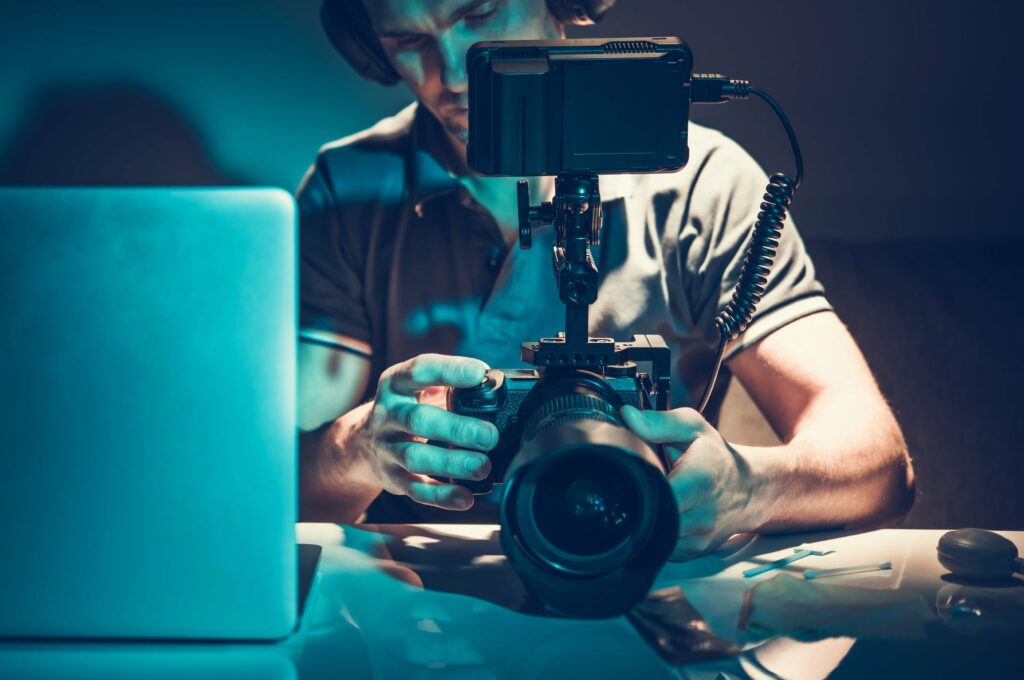Are you confused about the terms “royalty-free” and “copyright-free” when it comes to content? Don’t worry, you’re not alone. In this blog, we will break down these terms and help you understand what they really mean. We’ll start by decoding the term “royalty-free” and dispelling any misconceptions surrounding it. Then, we’ll do the same for “copyright-free” content. We’ll address any risks involved in using royalty-free and copyright-free content, such as licensing requirements, potential copyright claims, and how to avoid infringement. Finally, we’ll explore how you can use both types of content in your YouTube videos, including steps to incorporate them correctly and whether or not you can monetise your videos. If you have been struggling to navigate the world of content rights, this article is here to help clarify things for you.
Table of contents
- Decoding the term ‘Royalty-Free’
- Decoding the term ‘Copyright Free”
- Are there any risks involved in using royalty-free and copyright-free content?
- How to use royalty-free and copyright-free content for YouTube videos
- What type of content does Mixkit have?
- Where can I get more royalty-free assets for my creative projects?
Decoding the term ‘Royalty-Free’
Royalty-free refers to the licensing agreement between the content creator and the user. It means that you can use a piece of content multiple times without paying royalties or additional fees. However, it’s important to note that royalty-free does not always mean that the content is free or in the public domain; it simply refers to the licensing agreement. Typically, this kind of agreement grants non-exclusive rights to use the content. Therefore, before using any royalty-free content, it is crucial to understand and comply with the terms and conditions of the license. This ensures that you are using the content legally and avoiding any copyright issues.
Still confused? Don’t fret, we got you…
What does royalty-free mean?
When we talk about “royalty-free,” we’re referring to a licensing agreement where the user pays a one-time fee to access and use the content without any additional charges. This type of license allows the user to utilise the content multiple times without having to pay royalties for each use. However, it’s important to note that royalty-free doesn’t mean the content is free of copyright either. Instead, it means that the user has obtained permission from the creator to use the content within the terms of the agreement. In other words, the user doesn’t have to attribute the creator or pay royalties based on usage or sales. Royalty-free content is commonly used for stock photos, music, videos, and other digital content. Learn more about the ins and outs of royalty-free rights here.
Misconceptions about royalty-free content
- One common misconception is that royalty-free means the content is free of charge, but in reality, it refers to the licensing terms. It’s important to read the specific licensing agreement for each royalty-free content provider to understand its usage and limitations.
- Another misconception is that royalty-free content can be used without any restrictions. However, there might still be restrictions on usage, such as limited distribution or editorial use only.
Despite these misconceptions, royalty-free content offers flexibility and convenience for creators and businesses, allowing them to use the content multiple times without additional payment.
What is royalty-free music and footage?
Royalty-free music or footage refers to music or video clips that can be used without the need to pay royalties for each use. It means that once a user has purchased the audio file or footage, they can use it multiple times without any additional charges. For a deeper look at royalty free music rights you can learn more here.

Decoding the term ‘Copyright Free”
Copyright-free is a term that’s often used incorrectly. In reality, it refers to works that are in the public domain, meaning they are not protected by copyright. These works can be used freely without seeking permission or facing any legal repercussions. On the other hand, copyright protection grants exclusive rights to the creator of a work, allowing them to control how it is used, reproduced, and distributed. When using copyrighted works, it’s important to understand the licensing terms and obtain proper permission or licenses to avoid copyright infringement.
Want further explanation?…
What does copyright free mean?
Works labeled as ‘copyright free’ refer to works that are not protected by copyright and can be used freely without permission or payment. These works can include content that is in the public domain, meaning their copyrights have expired or been waived. However, it is essential to verify the status of a work before using it, as ‘copyright free’ does not necessarily mean it is completely unrestricted. Some ‘copyright free’ works may still have certain limitations, such as requiring attribution or being suitable for non-commercial purposes only. Understanding these nuances is key to avoid infringing on intellectual property rights.
Misconceptions about copyright free content
- Contrary to popular belief, copyright free content is not automatically in the public domain. While it may not be subject to traditional copyright restrictions, it still enjoys copyright protection. The difference lies in the fact that the owner has granted certain usage rights without the need for explicit permission.
- Using copyright free content does not exempt you from providing proper attribution to the creator. Even though you are not required to seek permission, acknowledging the original source is still recommended.
- To make the most of copyright free content, make sure to familiarise yourself with the specific terms and conditions associated with each piece. Not all copyright free content is created equal, and different works may have different usage limitations.
- Lastly, it is crucial to dispel the misconception that copyright free means unlimited freedom to use the content for any purpose. While it may grant more flexibility, there may still be certain restrictions or limitations on how you can utilise it.
What is “Copyright-Free” music?
Copyright-free music refers to music that is not protected by copyright law and can be used without permission or payment of royalties. However, keep in mind that “copyright-free” doesn’t mean it’s completely free to use without any restrictions. Some music may still have certain requirements or limitations.
Are there any risks involved in using royalty-free and copyright-free content?
While using royalty-free and copyright-free content, it’s important to be aware of the potential risks. One such risk is the possibility of someone claiming copyright ownership of the content you use. To avoid legal issues, always check the terms and conditions of the content provider and give proper credit to the source.
Understanding licensing requirements and restrictions
As previously explained, royalty-free content typically involves an upfront payment, allowing for multiple uses without additional fees. On the other hand, copyright-free content can be used freely without any copyright restrictions or permissions. However, it is important to note that both types of content may still have certain limitations on their usage, such as for personal or commercial purposes. Before utilising any type of content, it is crucial to carefully read and understand the licensing agreements and restrictions associated with it. Violating these requirements or copyright laws can lead to serious legal consequences. Remember to always adhere to the licensing terms to avoid any potential issues. If you cannot understand the requirements from the terms and conditions, it may be worthwhile seeking your own legal advice to see if the content is suitable for your use case.
Dealing with potential copyright claims
When it comes to dealing with potential copyright claims, both royalty-free and copyright-free content provide some level of protection. With royalty-free content, you have legal safeguards against copyright claims, while copyright-free content eliminates the risk of such claims altogether. However, it’s important to note that there is still a small possibility of mistaken copyright claims with both types of content. To minimise these risks, it’s crucial to adhere to usage guidelines and provide proper attribution when using any form of content. Additionally, conducting thorough research and using reputable sources can further reduce the chances of encountering copyright claims.
Using royalty free music for commercial use
When it comes to using royalty-free music for commercial purposes, there are a few important points to consider. First, royalty-free music allows you to use the music without paying any additional fees, making it a cost-effective option for your commercial projects. While royalty-free music grants you certain usage rights, it’s essential to be cautious with copyright claims as some restrictions may still apply. Always remember to credit the artist or source of the royalty-free music in your commercial projects, as giving proper attribution is both respectful and often legally required. To ensure the legality and quality of the music, consider using a reputable royalty-free music platform.
How to use royalty-free and copyright-free content for YouTube videos
When creating YouTube videos, it’s important to understand the difference between royalty-free and copyright-free content. Royalty-free content allows you to use music, images, and videos without paying royalties for each use. On the other hand, copyright-free content means that the owner has waived certain usage restrictions, but it still has copyright protection. To find and use royalty-free and copyright-free assets, you can explore platforms like YouTube Audio Library, Envato Elements, and stock photo sites. When using these assets, make sure to properly attribute and credit the creators. Remember to follow best practices to avoid copyright infringement and stay compliant with YouTube’s content policies.
Steps to incorporate royalty-free assets
- To incorporate royalty-free assets into your content, start by identifying your specific needs and searching for assets that align with your vision.
- Look for reputable websites and libraries that offer high-quality royalty-free images, videos, and music.
- Once you find the assets you want, download them and carefully review the licensing terms to ensure they meet your intended use.
- When incorporating these assets into your YouTube videos, be sure to give proper attribution if required.
By following these steps, you can confidently use legally safe content without the risk of copyright infringement.

Can you monetise YouTube videos with royalty-free and copyright-free content?
Monetising YouTube videos with royalty-free and copyright-free content is possible. Such content allows you to use it without paying royalties or infringing on someone’s copyright. However, make sure to check the specific terms of the content license for commercial use and attribution requirements. Some “free” resources may have hidden restrictions or require payment for certain uses. To avoid any issues, it is advisable to credit and attribute the copyright-free resources used in your YouTube videos. Additionally, consider using trusted sources or platforms to access copyright-free content.
Using Mixkit content in your YouTube videos
Using Mixkit’s content in your YouTube videos can greatly enhance the production value without worrying about copyright issues or licensing fees. With a wide range of royalty-free and copyright-free videos, music, and sound effects, Mixkit offers high-quality resources that can give your videos a professional look and feel. The Mixkit licensing terms are easy to understand, making it simple and straightforward to use Mixkit’s content. By incorporating Mixkit’s content into your YouTube videos, you can save time and effort in creating original material while still maintaining the desired level of quality. Read our license for each item type and make the most of Mixkit’s library to take your YouTube videos to the next level!
What type of content does Mixkit have?
At Mixkit, our content is 100% royalty-free and available for free to download. Our music, templates, and sound effects are licensed for free use in commercial projects – forever. For our video clips, please check the applicable license highlighted on the item page.
You may occasionally receive a Content ID claim on YouTube or a similar automated copyright claim on audio content you have downloaded from Mixkit. However, you can confidently use the content under our free license on YouTube, and any such claims are most likely being made in error.
Where can I get more royalty-free assets for my creative projects?
If you’re in need of images, motion graphics, graphic templates, or other assets beyond video creation, look no further than Envato Elements. They offer a wide range of royalty-free assets to choose from, plus they offer unlimited downloads at one low price. Find out more about Envato Elements.
Understanding the difference between royalty-free and copyright-free content is crucial for creators and businesses alike. Royalty-free content allows you to use the material without paying royalties for each use, making it a cost-effective option. On the other hand, copyright-free content means that the material is not protected by copyright and can be used freely without any restrictions. It’s important to note that while using royalty-free or copyright-free content can save you from legal issues, you still need to follow licensing requirements and be cautious of potential copyright claims. Whether you’re creating YouTube videos or sourcing assets for your projects, there are various platforms available that offer a wide range of royalty-free and copyright-free content, with Mixkit being a great place to start!




